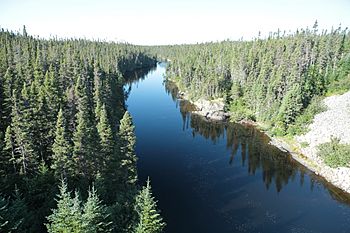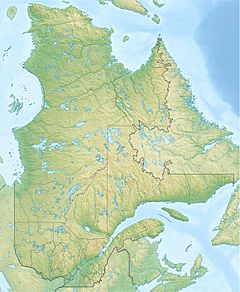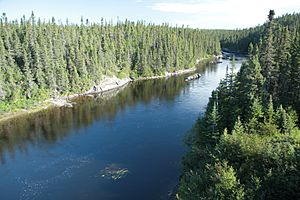Quetachou River facts for kids
Quick facts for kids Quetachou River |
|
|---|---|

The river mouth from Quebec Route 138
|
|
| Country | Canada |
| Province | Quebec |
| Region | Côte-Nord |
| RCM | Minganie |
| Physical characteristics | |
| Main source | Lac de la Robe Noire |
| River mouth | Gulf of Saint Lawrence 0 metres (0 ft) 50°18′37″N 62°43′26″W / 50.3102778°N 62.7238889°W |
| Basin features | |
| Basin size | 1,017 square kilometres (393 sq mi) |
The Quetachou River (French: Rivière Quetachou) is a river in the Côte-Nord region of Quebec, Canada. It flows into the Gulf of Saint Lawrence.
Contents
Where is the Quetachou River?
The Quetachou River starts above Lac de la Robe Noire. This lake also gets water from Lac François and Lac Gendron. The river then flows into Baie Quetachou from the northwest. The Veronique River also flows into this bay.
The river's mouth is in the town of Baie-Johan-Beetz. This town is part of the Minganie Regional County Municipality. No one knows for sure where the name "Quetachou" comes from. The name became official on December 5, 1968.
Exploring the River Trail
A walking path follows the river for about 10 kilometres (6.2 mi). This path starts near the village of Baie-Johan-Beetz. It leads to the Chutes Quétachou, which are a series of waterfalls.
In 2013, a forest fire burned many trees north of the village. This included the forests along the walking path. Two years later, a TV show shared a special project. Nine artists worked to bring beauty back to the trail. Their project was called Quétachou: résilience du territoire. This means "Quétachou: resilience of the territory." Local community members also helped with this project. The art pieces placed in the forest will slowly change as nature grows back.
The Quetachou River Area
The area around the Quetachou River is called its basin. This basin covers 1,017 square kilometres (393 sq mi). It is partly in the unorganized territory of Lac-Jérôme. The other part is in the town of Baie-Johan-Beetz.
The Quetachou River basin is located between the Piashti River and the Véronique River basins. Many lakes are found in this area. These include Lac Uhu, Lacs de la Cabane Brûlée, Lac Devost, Lac Croche, Lac Bellanger, Lac Napoléon, Lac Beetz, Lac Noroy, Lac de la Robe Noire, Lac François, and Lac Gendron.
Lac de la Robe Noire
Lac de la Robe Noire means "Black Robe Lake." It gets water from Lac François and Lac Gendron. The Quetachou River flows out of this lake. It then passes through lakes Beaulieu and Beetz before reaching the Gulf of Saint Lawrence.
This lake is about 16 kilometres (9.9 mi) long and 4 kilometres (2.5 mi) wide. It has many islands and peninsulas along its shore. In 1899, a surveyor named Hould said the lake was full of trout. He also noted it was near the source of the large Piasthibaie River (Piashti River). The Club Lac de la Robe Noire has special rights to fish here.
A book from 1914, Dictionary of Rivers and Lakes of the Province of Quebec, said the name "Black Robe Lake" was new. It referred to Catholic missionaries who came to teach the Innu people. These missionaries often wore long black robes, which is why they were called "black robes." The Innu language name for the lake is Matnipi, meaning "Bad Lake."
Lac Bellanger
Lac Bellanger is a large, wide part of the Quetachou River. It is about 20 kilometres (12 mi) north of where the river meets the sea. The Bellanger River flows into this lake.
The lake has a very uneven shape and covers 14 square kilometres (5.4 sq mi). It is named after Abbé Joseph-Marie Bellanger. He was a missionary and wrote a book about the Mi'kmaq language. The Innu people call this lake Pepaukamau. This means "lake with several straits."
Lacs de la Cabane Brûlée
The Lacs de la Cabane Brûlée means "Burnt Cabin Lakes." They are located west of the Quetachou River. People believe they are named after a cabin that burned down near one of the lakes. They are also sometimes called the Lacs Brûlé, or "Burnt Lakes."
Lac Noroy
Lac Noroy is named after Jean Bochart de Champigny. He was an important leader in New France from 1686 to 1702. He was also known as the Lord of Noroy and Verneuil.



